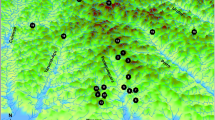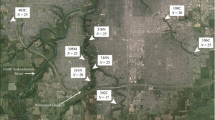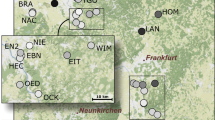Abstract
The security of the northern leopard frog (Rana pipiens) varies spatially with populations east and west of North Dakota considered as secure and at risk, respectively. We used genetic markers to characterize the conservation status of northern leopard frog populations across North Dakota. We used multiple regression analyses and model selection to evaluate correlations of expected heterozygosity (H E ) with the direct and additive effects of: i) geographic location, ii) wetland density and iii) average annual precipitation. There was lower genetic diversity in the western portion of the state due to lower levels of diversity for populations southwest of the Missouri River. This may reflect a refugial/colonization signature for the only non-glaciated area of North Dakota. Genetic diversity was also positively associated with wetland densities which is consistent with the reliance of this species on a mosaic of wetlands. Our findings suggest that populations in the southwestern part of North Dakota are of higher conservation concern, a finding consistent with the higher risk noted for northern leopard frog populations in most states west of North Dakota. Our findings also pose the hypothesis that climate change induced changes in wetland densities will reduce genetic diversity of northern leopard frog populations.


Similar content being viewed by others
References
Burnham KP, Anderson DR (2002) Model selection and multimodel inference: a practical information-theoretic approach, 2nd edn. Springer, New York
Caldwell I, Vitt LJ, Gibbons JW (1991) Declining amphibian populations: the problem of separating human impacts from natural fluctuations. Science 253:892–895
Chevan A, Sutherland M (1991) Hierarchical partitioning. The American Statistician 45:90–96
Conly FM, van der Kamp G (2001) Monitoring the hydrology of Canadian prairie wetlands to detect the effect of climate change and land use changes. Environmental Monitoring and Assessment 67:195–215
Corn PS, Fogleman JC (1984) Extinction of montane populations of the northern leopard frog (Rana pipiens) in Colorado. Journal of Herpetology 18:147–152
Cory L (1952) Winter kill of Rana pipiens in shallow ponds. Herpetological Review 8:32
Cowardin LM, Carter V, Golet FC, LaRoe ET (1979) Classification of Wetlands and Deepwater Habitats of the United States. U.S. Department of the Interior, Fish and Wildlife Service, Washington, DC. FWS/OBS-79/31
Dole JW (1965) Summer movements of adult leopard frogs, Rana pipiens Schreber, in northern Michigan. Ecology 46:236–255
Dyke AS (2004) An outline of North American deglaciation with emphasis on central and northern Canada. Developments in Quaternary Sciences 2:373–424
ESRI (2009) ArcGIS, version 9.3. Environmental Systems Research Institute, Redlands
Euliss NH Jr, Mushet DM (2004) Impacts of water development on aquatic macroinvertebrates, amphibians, and plants in wetlands of a semi-arid landscape. Aquatic Ecosystem Health and Management 7:73–84
Fisher JDL (2015) Northern Leopard Frogs in North Dakota: assessing the conservation status of a widespread amphibian species. Ph.D. Dissertation, North Dakota State University, Fargo, ND
Hoffman EA, Blouin MS (2004a) Evolutionary history of the Northern Leopard Frog: reconstruction of phylogeny, phylogeography, and historical changes in population demography from mitochondrial DNA. Evolution 58:145–159
Hoffman EA, Blouin MS (2004b) Historical data refute recent range contraction as a cause of low genetic diversity in isolated frog populations. Molecular Ecology 13:271–276
Hoffman EA, Ardren WR, Blouin MS (2003) Nine polymorphic microsatellite loci for the northern leopard frog (Rana pipiens). Molecular Ecology Notes 3:115–116
Hoffmann A, Sgro C (2011) Climate change and evolutionary adaptation. Nature 470:479–485
Johnson WC, Millett BV, Gilmanov T, Voldseth RA, Guntenspergen GR, Naugle DE (2005) Vulnerability of northern prairie wetlands to climate change. Bioscience 55:863–872
Johnson WC, Werner B, Guntenspergen GR, Voldseth RA, Millett B, Naugle DE, Tulbure M, Carroll RWH, Tracy J, Olawsky C (2010) Prairie wetland complexes as landscape: functional units in a changing climate. Bioscience 60:128–140
Larson DL (1995) Effects of climate on numbers of northern prairie wetlands. Climatic Change 30:169–180
Leonard WP, McAllister KR, Friesz RC (1999) Survey and assessment of northern leopard frog (Rana pipiens) populations in Washington state. Northwestern Naturalist 80:51–60
Mac Nally R (2000) Regression and model-building in conservation biology, biogeography and ecology: the distinction between–and reconciliation of–‘predictive’and ‘explanatory’models. Biodiversity & Conservation 9:655–671
Marsh DM (2001) Fluctuations in amphibian populations: a meta-analysis. Biological Conservation 101:327–335
McKay AM, Lance SL, Jones KL, Hagen C, Glenn TC (2011) Development and characterization of 18 microsatellite loci for the Southern Leopard Frog, Rana sphenocephala. Conservation Genetics Resources 3:267–269
Merrell DJ, Rodell CF (1968) Seasonal selection in the leopard frog, Rana pipiens. Evolution 22:284–288
Mushet DM, Euliss NH, Chen Y, Stockwell CA (2013) Complex spatial dynamics maintain northern leopard frog (Lithobates pipiens) genetic diversity in a temporally varying landscape. Herpetological Conservation and Biology 8:163–175
Mushet DM, Neau JL, Euliss NH (2014) Modeling effects of conservation grassland losses on amphibian habitat. Biological Conservation 174:93–100
Mushet DM, Goldhaber MB, Mills CT, McLean KI, Aparicio VM, McCleskey RB, Stockwell CA (2015) Chemical and biotic characteristics of prairie lakes and large wetlands in south-central North Dakota—Effects of a changing climate. US Geological Survey Scientific Investigation Report No. 2015–5126
NatureServe. 2015. NatureServe Explorer: An online encyclopedia of life [web application]. Version 7.1. NatureServe, Arlington, Virginia. Available http://explorer.natureserve.org. (Accessed: June 27, 2016)
Niemuth ND, Wangler B, Reynolds RE (2010) Spatial and temporal variation in Wet area of wetlands in the prairie pothole region of north Dakota and south Dakota. Wetlands 30:1053–1064
Olea PP, Mateo-Tomás P, de Frutos Á (2010) Estimating and modelling bias of the hierarchical partitioning public-domain software: implications in environmental management and conservation. PLoS ONE 5(7), e11698, http://doi.org/10.1371/journal.pone.0011698
Peakall R, Smouse PE (2006) GENALEX 6: genetic analysis in excel. Population genetic software for teaching and research. Molecular Ecology Notes 6:288–295
Phillipsen IC, Funk WC, Hoffman EA, Monsen KJ, Blouin MS (2011) Comparative analyses of effective population size within and among species: ranid frogs as a case study. Evolution 65:2927–2945
Poiani KA, Johnson WC, Swanson GA, Winter TC (1996) Climate change and northern prairie wetlands: simulations of long-term dynamics. Limnology and Oceanography 41:871–881
PRISM Climate Group, Oregon State University, http://prism.oregonstate.edu, created 4 Feb 2004
Reed DH, Frankham R (2001) How closely correlated are molecular and quantitative measures of genetic variation? a meta‐analysis. Evolution 55:1095–1103
Rice WR (1989) Analyzing tables of statistical tests. Evolution 43:223–225
Rivers MC, Brummitt NA, Lughadha EN, Meagher TR (2014) Do species conservation assessments capture genetic diversity? Global Ecology and Conservation 2:81–87
Rousset F (2008) Genepop’007: a complete reimplementation of the Genepop software for Windows and Linux. Molecular Ecology Resources 8:103–106
Van Oosterhout C, Hutchinson WF, Wills DPM, Shipley P (2004) MICRO-CHECKER: software for identifying and correcting genotyping errors in microsatellite data. Molecular Ecology Notes 4:535–538
Vander Wal E, Garant D, Festa-Bianchet M, Pelletier F (2013) Evolutionary rescue in vertebrates: evidence, applications and uncertainty. Philosophical Transactions of the Royal Society, B: Biological Sciences 368:20120090
Whitlock MC (1992) Temporal fluctuations in demographic parameters and the genetic variance among populations. Evolution 46:608–615
Wright CK (2010) Spatiotemporal dynamics of prairie wetland networks: power-law scaling and implications for conservation planning. Ecology 91:1924–1930
Acknowledgments
We thank Jacob Mertes for assistance with field work; P. Isakson (North Dakota Game and Fish) and Kevin Purcell for logistical support; Samantha Skinner and Anthony Nelson for laboratory support; Robert Newman, Jeff LeClere, and Scott Collins for sampling guidance. We thank David Mushet for advocating this study and his consistent support throughout. Further, David along with three anonymous reviewers provided very valuable comments on an earlier version of this manuscript. We thank Mark Clark and Ned Dochtermann for advice on statistical analyses. This work has been conducted under North Dakota Scientific Collecting permit #GNF02923466 to CAS and NDSU IACUC #10047. This work was supported by a North Dakota State Wildlife Grant administered by Patrick Isakson and Steve Dyke. Stipend support for JDLF was provided by the NDSU Graduate School, the Environmental and Conservation Sciences Graduate program, the Biological Sciences Department, a Veterans Administration Education stipend, and a North Dakota Water Resources Grant. Additional support was provided through a USGS Northern Prairie Wildlife Research Grant to CAS.
Author information
Authors and Affiliations
Corresponding author
Rights and permissions
About this article
Cite this article
Stockwell, C.A., Fisher, J.D.L. & McLean, K.I. Clinal Patterns in Genetic Variation for Northern Leopard Frog (Rana pipiens): Conservation Status and Population Histories. Wetlands 36 (Suppl 2), 437–443 (2016). https://doi.org/10.1007/s13157-016-0847-3
Received:
Accepted:
Published:
Issue Date:
DOI: https://doi.org/10.1007/s13157-016-0847-3




